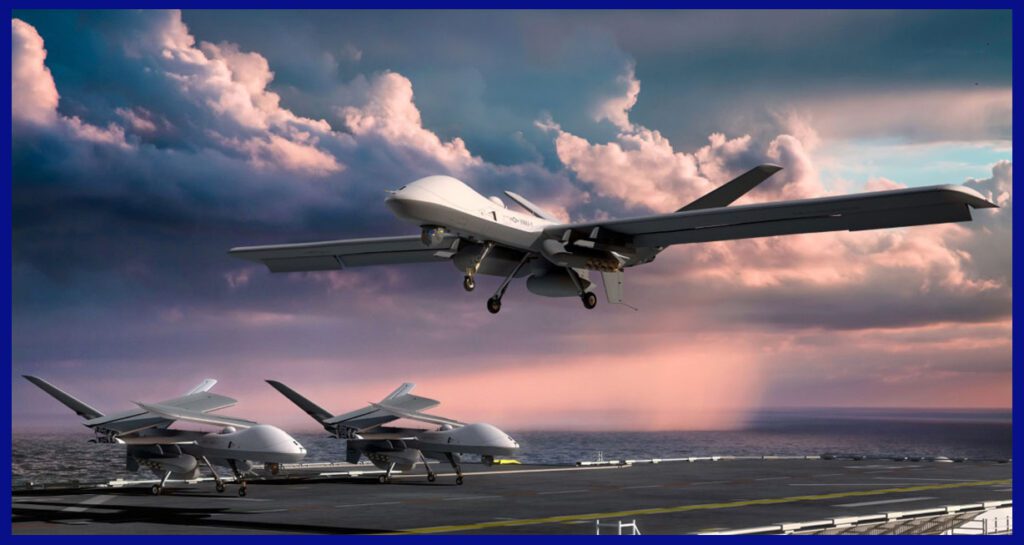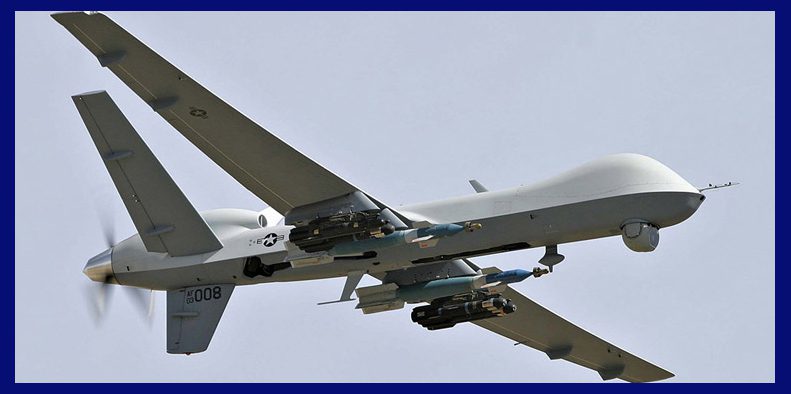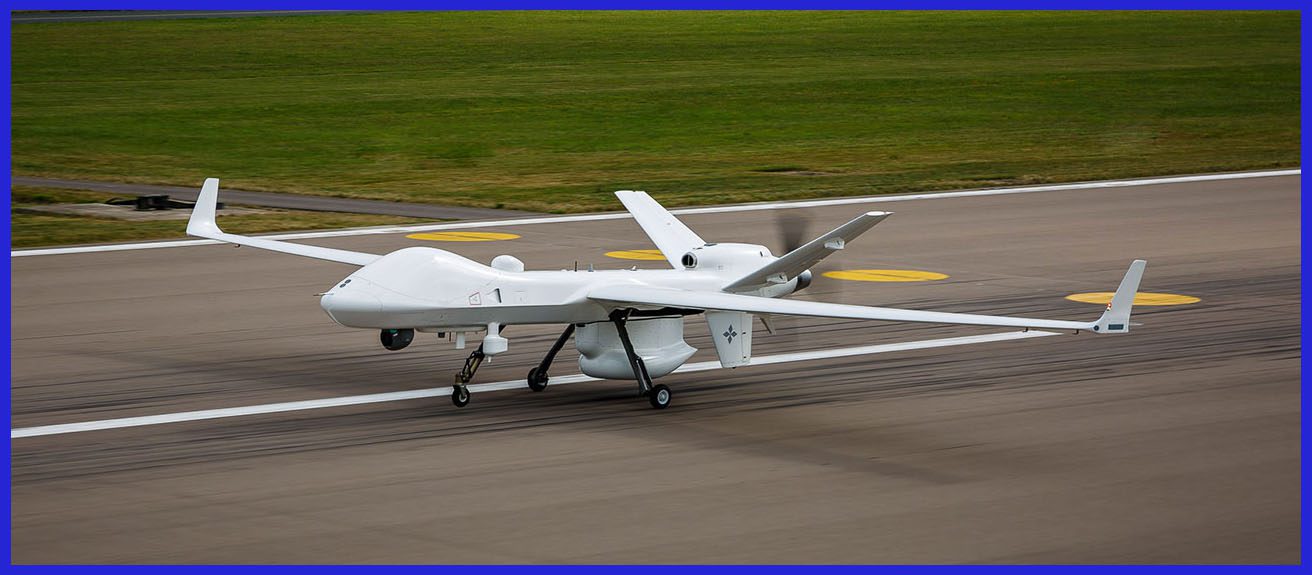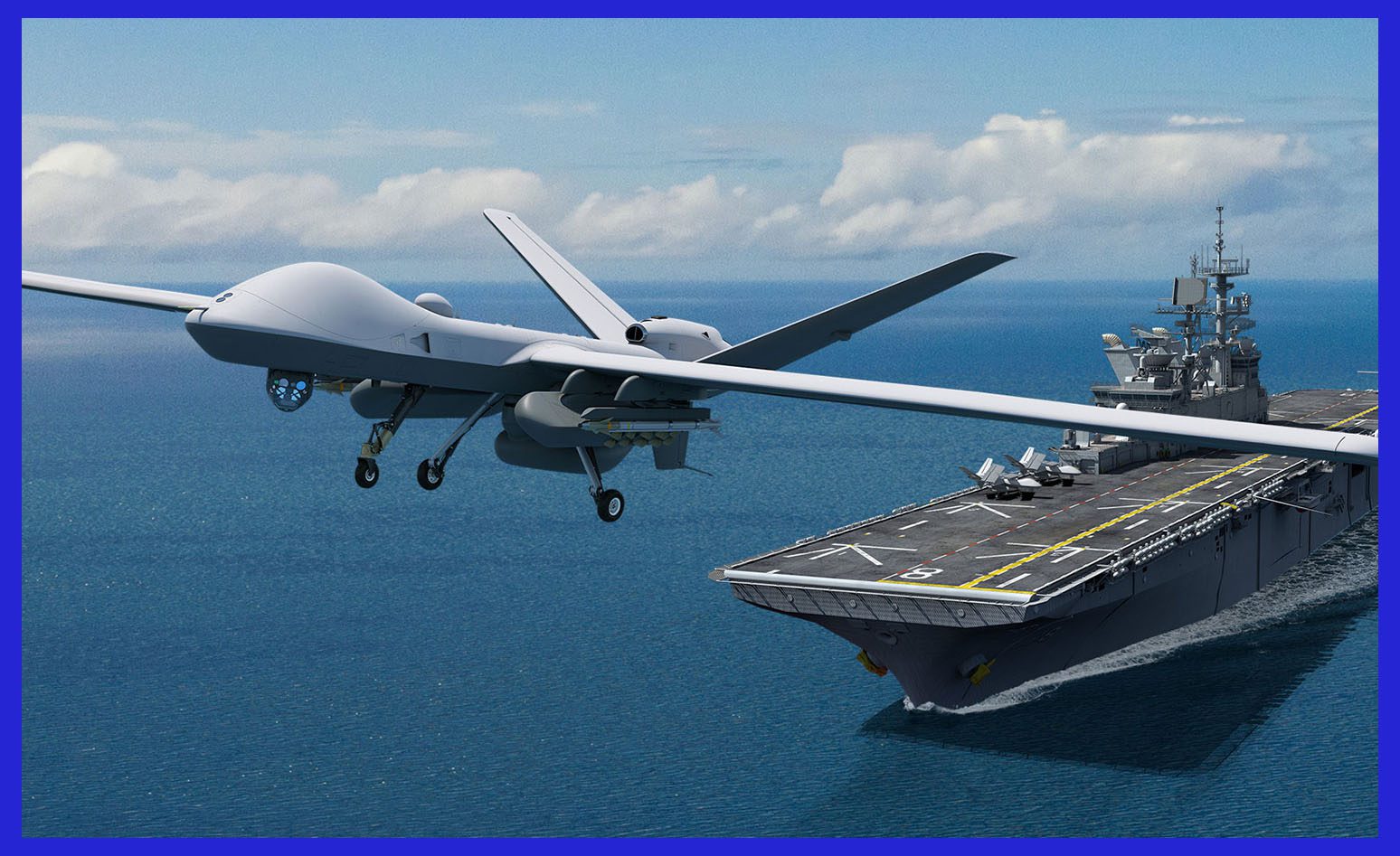An advanced maritime surveillance unmanned aerial vehicle (UAV) developed by General Atomics Aeronautical Systems, the MQ-9B SeaGuardian is designed to spend more than 30 hours flying over the horizon via satellite. It is the only drone that provides support in any difficult situation, whether it is day or night, where situational awareness is an extreme necessity to overcome the situation. Its capabilities make it a crucial asset for maritime security, border protection, and environmental monitoring.
The MQ-9B SeaGuardian is a Remotely Piloted Aircraft System (RPAS) specifically designed for maritime missions with the ability to incorporate or remove various maritime sensors. Its purpose is to facilitate real-time situational awareness in the maritime domain for joint forces and civil authorities, regardless of the time of day or night. SeaGuardian is engineered to conduct over 30+ hours of satellite-assisted flight (depending on configuration) in diverse weather conditions while ensuring safe integration into civil airspace.
This highly adaptable maritime patrol and reconnaissance aircraft seamlessly integrates a centerline wide-area maritime radar, an automatic identification system, electronic support measures, and a self-contained anti-submarine warfare (ASW) mission kit. It not only integrates cutting-edge maritime intelligence, surveillance, and reconnaissance (ISR) capabilities but also establishes itself as the first RPAS in its class to facilitate real-time search and patrol operations both above and below the ocean’s surface.

Development of the General Atomics MQ-9B SeaGuardian
The General Atomics MQ-9B SeaGuardian is a maritime variant derived from the MQ-9 Reaper unmanned aerial vehicle (UAV), which was originally developed by General Atomics Aeronautical Systems. The SeaGuardian is specifically designed for operations in open waters, offering extended intelligence, surveillance, and reconnaissance (ISR) capabilities tailored to maritime environments. The development of the MQ-9B SeaGuardian represents a progression from the successful MQ-9 Reaper, which has been widely utilized by numerous military forces worldwide for land-based missions.
Recognizing the requirement for an unmanned aircraft capable of effectively conducting maritime surveillance and security operations, General Atomics initiated the development of the SeaGuardian variant. This was prompted by the previous utilization of maritime variants of the MQ-9, referred to as Guardians, by the U.S. Coast Guard and U.S. Customs and Border Protection (CBP). CBP and the Coast Guard jointly operated an MQ-9 Guardian from land-based stations in Florida and Texas. Following their evaluation of the Guardian’s performance, they recognized the system’s advantages and explored the potential for future joint operations.
Subsequently, General Atomics continued its design and development efforts, evolving the Naval Reaper concept into the SeaGuardian variant. During the testing phase, the SeaGuardian demonstrated an endurance of over 18 hours. One significant aspect of its mission capabilities is the integration of the Leonardo Seaspray 7500E V2 AESA radar, which is mounted as a centerline pod and equipped with inverse synthetic aperture radar. This radar system enables the detection of surface targets, including ships, submarine periscopes, and individuals during search and rescue operations.
A variety of marine ISR operations can be performed with the SeaGuardian platform, such as
- Humanitarian Assistance/Disaster Relief
- Search and Rescue
- Law Enforcement
- Anti-Surface Warfare
- Anti-Submarine Warfare
- Airborne Mine Counter Measures
- Long-Range Strategic ISR
- Over-the-Horizon Targeting
Anti-Submarine Warfare (ASW) Capability of the MQ-9B SeaGuardian
General Atomics conducted a study in 2016 to test the sonobuoy launch capability of the Guardian. The purpose was to demonstrate its ability to carry, control, and transmit information from sonobuoys back to the ground station via a SATCOM link. In November 2020, a Reaper owned by the company successfully conducted a trial where it released sonobuoys and processed the gathered information to track a training target. This significant achievement paved the way for the development of an anti-submarine warfare (ASW) package for the SeaGuardian, making it the first unmanned aerial system (UAS) to possess a self-contained ASW capability.
Taking advantage of the MQ-9B’s open architecture system, SeaGuardian operators have the flexibility to integrate our groundbreaking sonobuoy management and control system (SMCS) as well as the sonobuoy dispenser system (SDS). These integrated systems empower SeaGuardian operators to deploy, monitor, and control sonobuoys from a single remotely piloted aircraft system (RPAS). Moreover, SeaGuardian boasts four wing stations that can accommodate up to four SDS pods, allowing it to store and dispense up to 40 ‘A’-size or 80 ‘G’-size sonobuoys. This capability enables SeaGuardian to execute ASW operations remotely in any part of the world.
In its standard configuration for maritime intelligence, surveillance, and reconnaissance (ISR) and ASW operations, SeaGuardian possesses a mission radius of 1200 nautical miles. This provides substantial on-station time for submarine detection and engagement, offering a cost-effective standalone capability or the potential for manned-unmanned teaming operations in conjunction with crewed aircraft.

Salient Features Of the MQ-9B SeaGuardian
- Intelligence, Surveillance & Reconnaissance
- High-definition EO/IR
- Automatic Identification system
- Lightning Protection and de-ice/Anti-Ice systems
- GA-ASI Lynx Multi-Mode Radar
- Multimode 360-degree Maritime Surface Search Radar
- Triple Redundant Navigators and Flight Computers
- Dual Redundant Flight Control Surfaces
- Open Architecture Mission System
- Dual VHF/UHF Certified radios
- SATCOM ATLC short runway capability
- Reduced operating footprint and manning
- Fire-protected engine bay
- All weather capable
- Fatigue and damage-tolerant airframe
- 40,000-hour service life

The General Atomics ‘MQ-9B’ SeaGuardian Technical Specifications
- Crew: It is remotely operated and monitored by 2 ground control stations (GCS) crews.
- Length: 38 ft ( 11.7 m )
- Height: 12 ft 6 in ( 3.81 m )
- Wingspan: 79 ft ( 24 m)
- Empty Weight: 2,223 kg ( 4,901 lb )
- Max takeoff weight: 5,670 kg ( 12,500 lb )
- Powerplant: 1 × Honeywell TPE331-10 turboprop engine
- Fuel capacity: 2,721 kg ( 6,000 lb )
- Maximum Speed: 482 km/h ( 300 mph )
- Mission Radius: 4,260 km ( 2,300 nmi ) based on configuration
- Endurance: 30+ hours ( 14 hours fully loaded with arms )
- Service ceiling: 40,000+ ft MSL
- Payload capacity: 2,155 kg ( 4,750 lb )
- Hardpoints: 9 in total ( 8 wings, 1 centerline ) with provisions to carry combinations of ASM ( Hellfire, Brimstone ) & Bombs ( Paveway, JDAM ) + Testing is underway to support the operation of the Air-to-Air Stinger missile as well, after the incident of interception of a Reaper in the Black Sea by Russian SU-27 on 14 March 2023.

However, don’t miss out on the extraordinary chance to own an exquisite collection of exclusive 1/72 premium diecast scale models showcasing the legendary General Atomics MQ-9 Reaper. These awe-inspiring models capture the essence and beauty of this iconic aircraft, allowing you to admire its sleek design and remarkable details up close. Whether you’re a passionate aviation enthusiast or a collector seeking unique pieces, this collection is a must-have, offering a rare opportunity to own a piece of aviation history.
In conclusion, The MQ-9B SeaGuardian is a groundbreaking unmanned aerial system (UAS) that revolutionizes surveillance and defence operations. With its extensive range, endurance, and adaptable sensor payload, the SeaGuardian provides unparalleled situational awareness and intelligence-gathering capabilities. Its operational versatility in both land and maritime environments makes it an invaluable asset for coastal surveillance, border patrol, maritime security, and search and rescue missions. Equipped with state-of-the-art sensors such as synthetic aperture radar (SAR), maritime patrol radar, and electro-optical/infrared (EO/IR) sensors, the SeaGuardian enables real-time monitoring, target detection, and tracking, enhancing operational efficiency.
Moreover, the SeaGuardian’s remarkable endurance and extended range allow for prolonged missions, minimizing the need for frequent refuelling or pilot rotation. This not only saves costs but also reduces human risk in hazardous or remote areas. The MQ-9B SeaGuardian represents a significant leap forward in UAS technology, offering a reliable, adaptable, and technologically advanced solution for various defence and security challenges. As technology continues to advance, platforms like the SeaGuardian will play an increasingly crucial role in shaping the future of surveillance, intelligence gathering, and global security.
Important Announcement for Our Valued Readers!
After an article is published, it is possible that updates or changes may have occurred beyond the time of publication. Therefore, it is important to be aware that certain information in the article might be outdated. To ensure the most accurate analysis, it is highly recommended to verify the content with the latest sources available.
However, we are dedicated to delivering outstanding articles on military products and global updates. Maintaining quality and smooth operation requires resources. Your support sustains our efforts in providing insightful content. By purchasing high-quality products through our affiliated links, you help us keep our platform alive and acquire top-notch items. Your unwavering support is invaluable and inspires us to strive further.
We welcome your suggestions and requests for more information, as we value feedback from our readers. If there’s specific defence material or equipment not covered on our site, please share your request in the comments. We’ll strive to research and provide the required information. We sincerely thank you for your unwavering interest in our website, and we eagerly anticipate hearing from you! Enjoy your reading experience!
